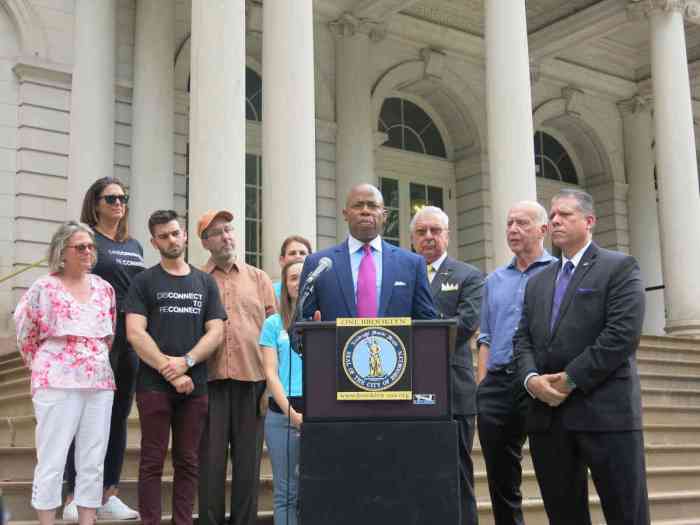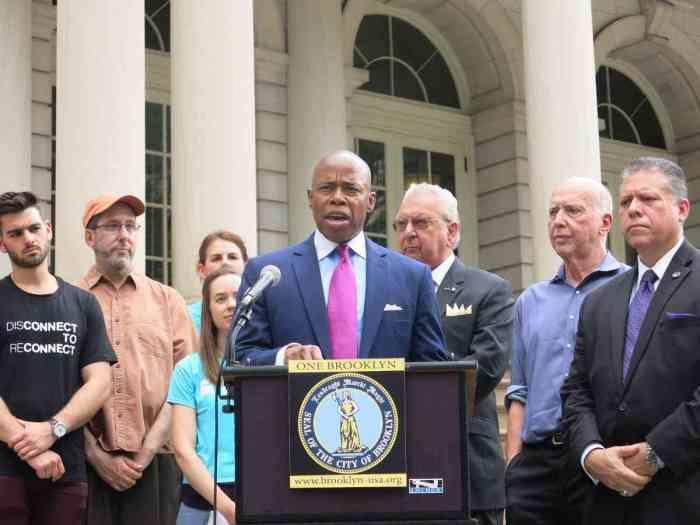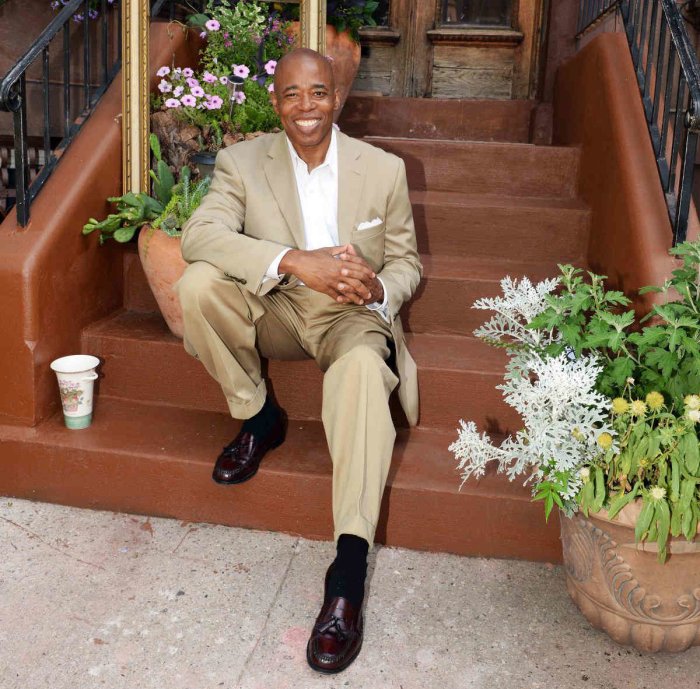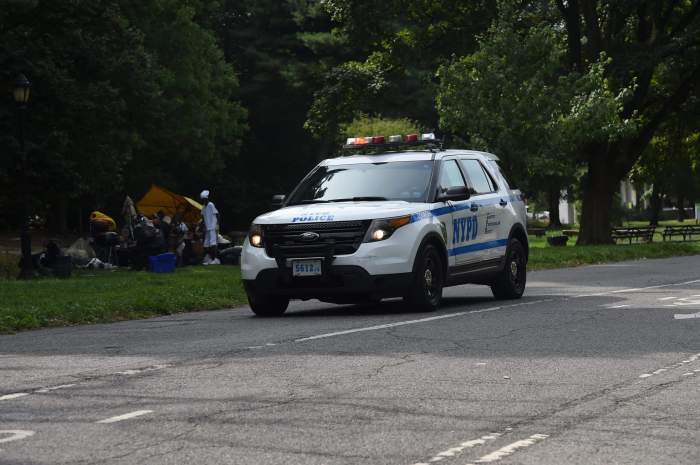Brooklyn’s new Borough President, Antonio Reynoso, has released a new “transition report” outlining his agenda and priorities for his young beepage, a boroughwide elected post with limited powers, but a large platform and bully pulpit.
The transition report outlines big plans for the best borough: he wants to enact a “comprehensive plan” for Brooklyn, delineating the amount of housing that should be built to alleviate a crushing housing shortage, where to build it, and how to do it equitably. He hopes to make Brooklyn the safest place for a woman of color to have a baby, and he wants to reform the borough’s community boards to encourage greater and more equitable civic participation. He is a self-described policy nerd, but also hopes to throw the best parties and to be remembered by generations of Brooklynites as a “fun guy.”
Reynoso previously represented Williamsburg and Bushwick for eight years on the City Council, and won a crowded Democratic primary before cruising to victory in the November general election.
He has had a busier transition into his new post than most other BPs, he said; his predecessor in the office, Eric Adams, is now the mayor, and he took much of his staff at Borough Hall with him to City Hall, leaving Reynoso with a challenge to get the ball rolling on implementing his agenda. Nevertheless, Brooklyn Paper caught up with him last week and discussed how he plans to both emulate and distinguish himself from his predecessors, his battle with the Brooklyn Democratic Party, and how to combat car culture, among other things. Our interview with the beep, lightly edited for clarity, is below:
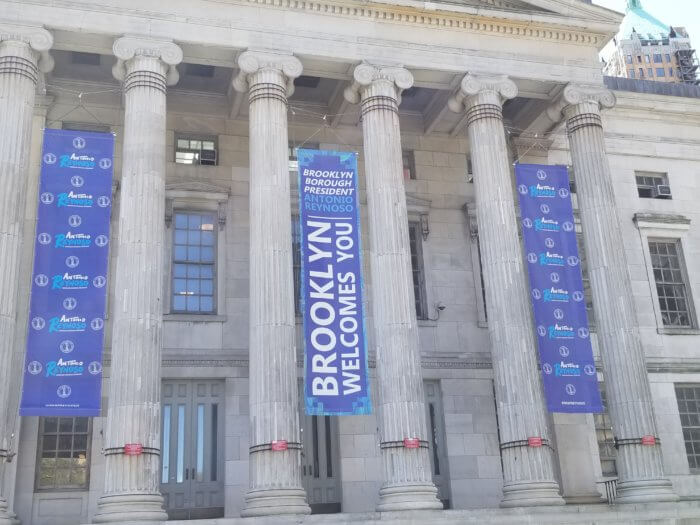
BROOKLYN PAPER: How would you differentiate your approach to the position from predecessors like Eric Adams and Marty Markowitz? And in what ways are you modeling your approach after theirs?
ANTONIO REYNOSO: I think what Marty Markowitz did well, that I’d love to model and emulate, is that he was the chief promoter of Brooklyn. Brooklyn all day, all the time. And he was very proud of Brooklyn, he loved Brooklyn, he showed Brooklyn off. And I want to do that work. I want to make sure that people feel the fun, feel the energy, and that Brooklyn is front and center in all the work that is happening here in the city, not only with its recovery but also just having a good time, and being able to show people how great Brooklyn is. So that I want to emulate from Marty.
Eric did a good job at putting forth an initiative, especially the healthy initiative that he was putting forward. And really do something with it, really focus on it, put resources in it. Meatless Mondays came about from it. We saw him take an initiative, a policy item, and see it come to fruition, to reality. Those are two things I would really like to see.
I think the difference would be, I want to do a little of both. I’m a big nerd, I love policy. So things like maternal mortality work we’re gonna be pushing, health. Comprehensive planning which is also something we’re gonna be doing that I think is of value and, outside of promoting Brooklyn, speaks to this position’s value. But I also want to throw the fun parties, and make sure we have the events, and make sure the culture of Brooklyn is vibrant and the people are seeing why it is we’re the greatest borough in the City of New York.
BP: In your transition report, you say you want to have a more comprehensive planning process. You say you want to increase the level of community input in planning decisions but you also say you want to combat NIMBYism on community boards. Some would say those goals are in conflict, so how do you thread that needle?
I’ve written about this before alongside Brad Lander. Right now, there’s what we call the “NIMBY-YIMBY death loop.” A proposal gets put forward, community’s up in arms, and it’s the same expectation every time with regards to this process. I think a comprehensive plan does something different here. It allows for the community to take time and self-determine what the future of the community’s gonna look like. And allow for developers to look at that as a framework for how they would want to build in that community, within the realms of what communities have put forth. But also not allowing communities to do nothing. It’s about tasking them.
Let’s say — and I’m just using this as a number right now because the comprehensive plan is gonna inform us exactly what it is — but let’s say we want 100,000 units of housing in Brooklyn over the next 5 years. We want to ask every community to be part of that solution. We don’t want to build 100,000 units in the same poor, Black and brown neighborhoods that have already taken on the responsibility of getting out of this housing crisis. We want to ask Sheepshead Bay, we want to ask Canarsie, Midwood, everyone, let’s all be a part of the solution.
So a comprehensive plan is going to build out characteristics of neighborhoods. And if your neighborhood falls in line with one of those characteristics, there’s going to be recommendations that will be put forth. And in it, it can say, 3,000 units of housing might need to be built in your community. So you need to tell us where those 3,000 units should go. But not no units, never, nothing’s gonna change. You’re gonna be part of the greater good here. And the comprehensive planning helps lay that out.
So it’s giving you an opportunity to tell us where you would want it, should you get it, and then allowing for developers to see that and build in places that the communities are more amenable to.
BP: Isn’t that what community boards are supposed to do in the first place? How would comprehensive planning be different, really?
Right now, I think the community boards themselves need to be, I guess, redirected or re-informed, they might not know exactly what their responsibilities are. A lot of people get appointed to these boards with no orientation of what roles they have, what mandates — put forth in the [city] charter — that are their responsibility. So I think a lot of it is growth and informing community boards of exactly what their power and influence is.
And the comprehensive plan is going to run through the community boards, the community boards are going to have input as to what that looks like. So if we feel community boards are the ground floor of civic engagement in Brooklyn, they are going to be part of dictating what the outcomes of this comprehensive plan are. But again, no one is going to be allowed to say no. They’re gonna have a mandate, they’re gonna have to abide by that mandate. And should the community board not be able to come up with solutions, the characteristics are gonna be put out there, and ultimately, the datasets are gonna be making the recommendations for them.
BP: One of Brooklyn’s most intractable problems has been affordable housing, and right now it’s something of a crisis, with landlords jacking up rents all over the place and the mayor signaling he wants to significantly raise rents on stabilized tenants. How do you want to use your powers and position to make Brooklyn more affordable?
The comprehensive plan is part of that foundation. The idea here is we need to build more housing across the board. The comprehensive plan allows for there to be a framework that makes it very clear to developers where development can happen and is encouraged. That’s one thing.
And it’s about affordability. We need to have a conversation about the city working alongside developers to create more affordable housing. But also, on city-owned land, allowing for there to be an opportunity for the city to build exclusively 100 percent affordable housing. But the system we have now, the [Uniform Land Use Review Process] system, doesn’t produce enough housing, and we’ve noticed that, the City of New York hasn’t produced enough housing over the last decade to fulfill its demand, the supply is not meeting it.
I think we need to change how we do zonings, and rezonings, and planning in this city, and it’s why we’re doing this comprehensive plan, it’s actually to solve for that. We could build faster, we could build more affordable, and we could do it with less tension. And that’s something the comprehensive plan solves for.
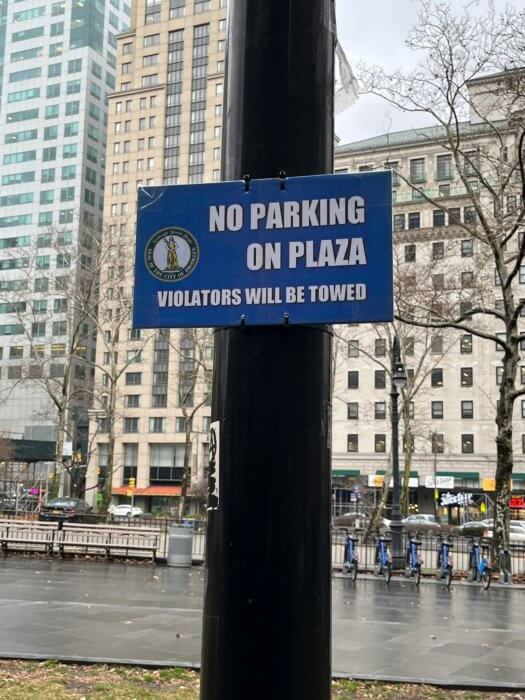
BP: A lot has been made of your banning parking at Borough Hall plaza, and calling for an end to parking minimums. In your ideal vision of Brooklyn, what does the streetscape look like, and how do you cut through the red tape?
My ideal situation would just be everyone follows the rules that already exist. It wasn’t ever supposed to be a parking lot, it’s a park, a plaza, it’s for pedestrians. Not for vehicles. Parking illegally is illegal, parking in a bike lane is illegal. If everyone just followed the laws that exist, we’d live in a much more transit-safe neighborhood, transit-secure neighborhood. So it’s not necessarily something I invented in my head or a fantasy. It’s just do what the law asks, and if more folks comply with the law we could have safer streets. So for me, it’s just the rules on the books, doing the best we can to follow suit.
I think a part of the question is something that I call “car culture.” People have normalized double parking, parking illegally, parking on a sidewalk or a park. People say “Oh, this is New York.” And it shouldn’t be. And it’s hard to show people that it isn’t that. Taking back streets through the open streets program is not “taking back” streets, we’re not “taking them back.” They never belonged to anyone. They always belonged to us, it’s open space. We’re giving residents of the city of New York the ability to drive their cars and park their cars in open space. That’s pretty much it. I think people are starting to see it, through the creation of open streets, outdoor dining, bike lanes. That they have control of the streets, and they don’t necessarily belong to cars. And I think the conversation happening is good, even if you’re against it. There was a time when it was all cars, all the time.
BP: You famously do not get along well with the county party and its boss, Rodneyse Bichotte Hermelyn. You’ve called for her to resign, and have endorsed the efforts of those who want to reform county committee. How do you think the party should be reformed, and how do you think its present state affects everyday Brooklynites?
Brooklyn is the largest population of Democratic voters in the country. And I just think that we should be an example of the democracy we want to see. And what I believe is that the Democratic Party has become an exclusive club for the few, and do everything in their power to gain as much influence as possible, to dictate the terms of what they want democracy to look like instead of it being a more voluntary and democratic process. I believe we should give more power to county committee members, and allow them to have a say in what the party’s going to look like.
And, ultimately, I began this work when I was 22 years old, when we started New Kings Democrats. The idea was that a bunch of nerds wanted to come together to help the party. We wanted to knock on doors, we wanted to hand out leaflets, we wanted to get signatures, we wanted to do all the work nobody wants to do. We were kind of commanded by the ultimate Democrat, who at the time was the President of the United States Barack Obama, to get involved in our local party. Instead we have a local party that absolutely does not want county committee members to be involved, that does more appointments of county committee members than actual people wanting to be a part of the process. It’s all top-heavy.
Also, a Democratic Party that has no problem trying to kick people off the ballot with fake signatures, then how can we allow for more people to be involved in the democratic process? As a councilmember and now as a Borough President, I’ve never challenged petitions or signatures. I let the people decide who they think is the best candidate. And I feel like the Democratic Party shouldn’t be attempting to throw out other Democratic Party members. They want to battle against Republicans? That I would understand a little better. But battling against their own party? It just doesn’t make sense to me.
So what we’re going to do is keep trying to gain power, which we have done. We have more district leaders than ever, we have more county committee members than ever, we won more judgeships this last election than ever. The county party took a large hit. If it wasn’t for the mayor winning, the Brooklyn Democratic Party would be as weak as it’s ever been.
But, we have no problem, even at this moment, sitting down with Rodneyse Bichotte and have a conversation about what we expect the Democratic Party to look like. But we have not been awarded that opportunity.
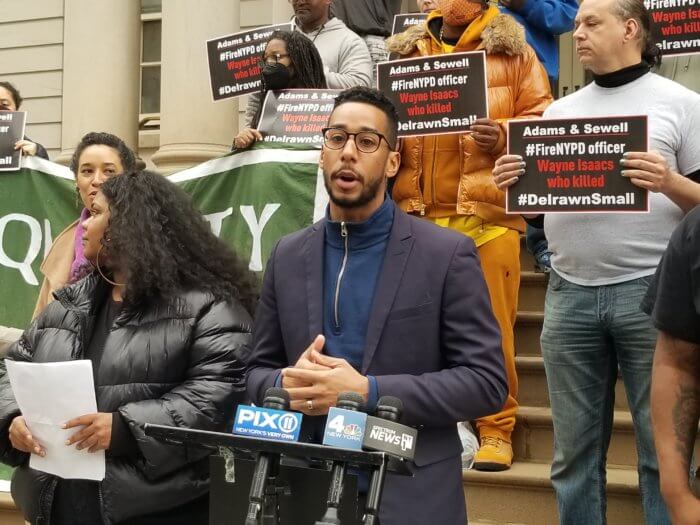
BP: You mentioned earlier that your predecessors, Marty Markowitz and Eric Adams, are remembered for certain things. What do you hope people in the future associate the Reynoso beepage with?
I think it’s a little bit of all of it. I have this maternal mortality work that I’m doing. We’re spending all of our funding in the capital side to outfit these public hospitals with state-of-the-art birthing centers. We want Brooklyn to be the safest place for Black women to have babies. My goal is in four years, we did that, that Brooklyn is the place for any woman to have a baby, but specifically Black women. To have that in four years, in itself, I would feel like we’ve accomplished a lot.
But we also have this comprehensive plan. We also want to talk about resiliency along the waterfront, from Greenpoint all the way down to Gerritsen Beach. We want to talk about affordable housing through the comprehensive plan.
And we want to promote Brooklyn. I really feel that, in no criticism whatsoever, everyone has their own style of managing, but what Marty Markowitz was good at was these events and Brooklyn promotion, I don’t know if Eric, that was a priority for him, I feel he was really focused on the healthy lifestyle front. But I want people to remember me as, ‘oh, Antonio was a really fun guy. In the Chinese community he really centered his work around showing the culture, in the Pakistani community he did the same thing, the Afro-Caribbean community, he was everywhere, he was promoting all our cultures, making us feel like Brooklyn was a part of us.’ So that’s also something I’m looking forward to.
And I have the civically engaged Brooklyn, the community boards. I want to change the way community boards work, not fundamentally, but make it so that people want to be on the community board, and make it so that the community board has some influence and power over the future of what their communities look like.
So for me, I actually want to accomplish a lot. I don’t want to be defined by one thing, I want to be a Borough President where folks can name several things as to what made me a good Borough President. Point to several things.
BP: Back in the day, the beep had a lot more statutory power than it does today, back before the 1989 court decision and subsequent reorganization of city government. Do you think, in an ideal world, should the BP have more powers restored to the office or is it good as is?
When it comes to this type of stuff, the reconstruction of the New York City charter, New York City decided, and they thought this was the best decision. And I want to do the best I can with the charter-mandated responsibilities that were awarded to the Borough President’s office under the current structure. I don’t want to relitigate the past. I do want to say, the way the Board of Estimate was running and the Borough Presidents in the past, was something that was inequitable and unrepresentative of the people of the City of New York.
So I actually think that the changes that were made, the expansion to the City Council, the 51 members, is doing its job of having representative democracy, people are represented by people that look like them. So for whatever, the gains, the losses, the increase in power in influence or the decrease of that for anyone, was a decision made by the general public and I think New York City is good for where we are. If given the opportunity to talk about the other responsibilities a Borough President should have, I have no problem bringing that to the general public. But right now, the decision was made and we’re gonna work by it.
BP: Last question: your immediate predecessor, Eric Adams, is now the mayor. Is there any chance that one day, New York could see a Mayor Reynoso?
I have a foundational saying that was told to me. ‘The best electeds do the best work.” A wise man told me that. A wise man once told me, “Good work makes for good elected officials.'”For me, it’s just let me keep doing my good work. When I started as a councilmember, year one, I didn’t think I was gonna be the Borough President. I just did the work, and then the opportunity was awarded to me. So I want to do the same here, just be a great Borough President. And you know, the future is the future.
Thank you for taking the time to speaking with us.
I appreciate it, thank you so much.
Read Borough President Antonio Reynoso’s full transition report here. And check out our past interview with Reynoso following his primary victory last year on his vision for the office here.


















